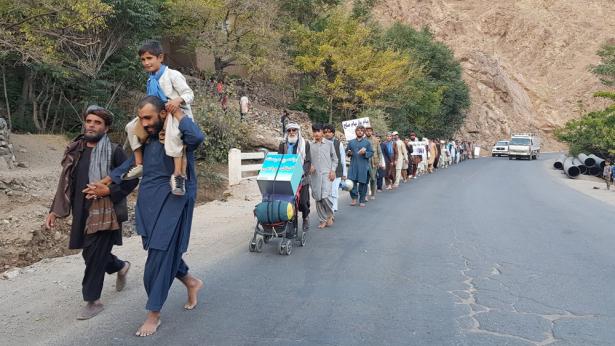On January 27, the Taliban and the U.S. government each publicly stated acceptance, in principle, of a draft framework for ongoing negotiations that could culminate in a peace deal to end a two-decade war in Afghanistan.
As we learn more about the negotiations, it’s important to remember others working toward dialogue and negotiation in Afghanistan. Troublingly, women’s rights leaders have not, thus far, been invited to the negotiating table. But several have braved potential persecution to assert the importance of including women in any framework aiming to create peace and respect human rights.
During a recent visit, a young medical student told me how she was deprived of schooling during the Taliban era. “If government doesn’t protect women’s basic rights,” she said, “we could lose access to health care and education.”
“The war was started by men, the war will be ended by men,” an aide to Rula Ghani, the wife of President Ashraf Ghani, recently told a Reuters reporter. “But it’s the women and children who suffer the most and they have a right to define peace.”
“The war was started by men, the war will be ended by men . . but it’s the women and children who suffer the most and they have a right to define peace.”
Another group not represented at the negotiating table is the “People’s Peace Movement.” Following deadly attacks in their home province of Helmand, the founders of this movement humbly walked, sometimes even barefoot, hundreds of miles as part of a campaign asking people to reject the entire institution of war. The movement urges an end to revenge and retaliation and calls on all warring parties to support a peace process. Their journeys throughout the country have become venues for informal hearings, allowing opportunity for people to collectively imagine abolishing war.
In 2018, the United Nations expressed alarm at the rising death toll among women and children as a result of increased use of airstrikes by U.S. and Afghan forces. In the run-up to the past week of negotiations and even during the negotiations, attacks, and counter attacks between the warring parties killed dozens of civilians, including women and children.
Both the Taliban and the United States seemed intent on showing strength and leverage by demonstrating their willingness to slaughter the innocent.
Activists in the United States have much to learn from Afghan women human rights advocates and the People’s Peace Movement regarding the futility of war.
Since 2001, and at a cost of at least $800 billion, the U.S. military has caused irreparable and horrific losses in Afghanistan. Afghan civilians have endured invasion, occupation, aerial bombings, ground attacks, drone warfare, extensive surveillance, internal displacement, soaring refugee populations, environmental degradation, and the practice of indefinite detention and torture.
How would U.S. citizens bear up under even a fraction of this misery? This litany of suffering would likely lead to increased insurgent resistance, rising support for the Taliban, and spiraling violence.
By late 2018, even a top military commander, Army General Scott Miller, told CNN the United States had no chance of a military victory in Afghanistan. The fight will continue, he stated, until there is a political settlement.As Major General Danny Sjursen wrote in December, the only thing left for the U.S. military to do in Afghanistan is to lose.Major General Sjursen was correct to concede inevitable U.S. military defeat in Afghanistan, but there is something more the U.S. public can and should do—pay reparations for the seventeen years of suffering we’ve caused in Afghanistan.
Regular reports to the U.S. Congress detail how waste, embezzlement, fraud, and abuse of U.S. funds undermine reconstruction efforts in Afghanistan.
The United States has already provided more than $132 billion for reconstruction in Afghanistan. But has that sum made a significant difference in the lives of Afghan people impoverished by displacement and war? I think not, and here’s why: Since 2008, John Sopko, the Special Inspector General for Afghan Reconstruction, has submitted quadrennial reports to the U.S. Congress detailing how waste, embezzlement, fraud, and abuse undermine reconstruction efforts. The work of Sopko and his research team provides a chance for people in the United States to see ourselves as we’re often seen by an increasingly cynical Afghan public. But we seldom even hear of these reports. In fact, when President Trump learned of these watchdog reports during his first Cabinet meeting of 2019, he was infuriated and said they—the reports—should be “locked up.”U.S. citizens often regard their country as a civilized nation that goes to war against demonic tyrants. If only we could hear from other people menaced by our militarism, especially women and children, if we could see how our wars have contributed to terrorism, corruption, and authoritarianism. The United States has become a permanent warfare state.
We must find the same courage that inspires brave people in Afghanistan to speak up and resist the all-encompassing tyranny of war.
Kathy Kelly, Co-coordinater of Voices for Creative Nonviolence


Spread the word